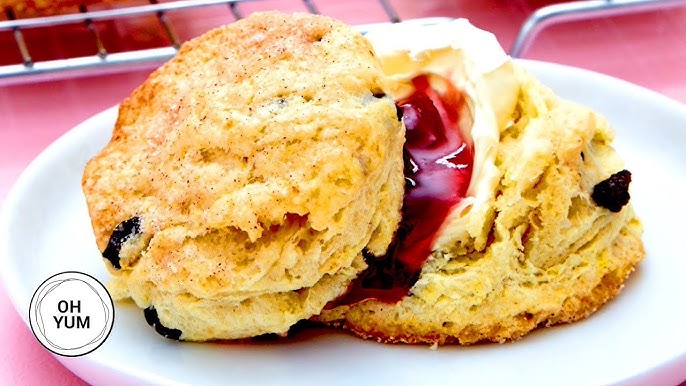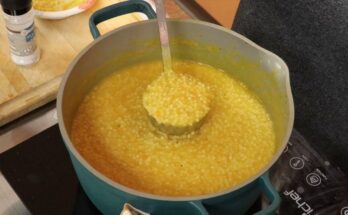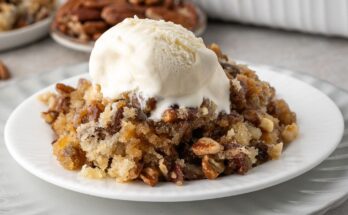Scones Recipe: Scones are a beloved baked treat, perfect for breakfast, tea time, or dessert. Whether you like them sweet or savory, this comprehensive guide will help you make the perfect scones every time.
Let’s dive into this step-by-step process!
Ingredients Needed for Scones
Basic Ingredients
To make scones, you’ll need:
- 2 cups of all-purpose flour
- 1/4 cup granulated sugar
- 1/2 cup unsalted butter (cold and diced)
- 2 tsp baking powder
- 1/4 tsp salt
- 3/4 cup milk or heavy cream
- 1 large egg (optional for a richer texture)
Optional Ingredients for Variations
Elevate your scones by adding:
- 1/2 cup chocolate chips
- 1/2 cup dried fruits like raisins or cranberries
- 1/4 cup shredded cheese and herbs for a savory twist
Tools and Equipment Required
Essential Tools
- Large mixing bowl
- Whisk or fork
- Baking tray
- Parchment paper or a silicone mat
- Rolling pin (optional, depending on your shaping method)
Optional Tools for a Professional Touch
- Pastry cutter for blending butter
- Food processor for quick mixing
- Cooling rack for even cooling
Preparing Your Workspace
Organizing Ingredients
Before starting, measure all your ingredients. This step ensures a smooth workflow and minimizes errors.
Cleaning and Setting Up Tools
Ensure all tools are clean and within reach. Pre-line your baking tray with parchment paper to save time later.
Step-by-Step Scone Preparation
Preheating the Oven
Preheat your oven to 400°F (200°C). A properly heated oven is crucial for even baking and achieving the desired rise.
Mixing Dry Ingredients
In a large mixing bowl, whisk together the flour, sugar, baking powder, and salt. This ensures the leavening agent is evenly distributed.
Incorporating Butter
Using a pastry cutter or your fingers, cut the cold butter into the dry ingredients until the mixture resembles coarse crumbs. The cold butter creates flaky layers in the scones.
Adding Wet Ingredients
In a separate bowl, whisk the milk and egg (if using). Gradually pour this mixture into the dry ingredients. Stir gently with a fork until just combined. Overmixing can lead to tough scones.
Kneading and Shaping the Dough
Turn the dough out onto a lightly floured surface. Knead it gently 3–4 times to bring it together. Flatten it to about 1-inch thickness. Use a biscuit cutter or a knife to shape the scones into rounds or wedges.
Baking the Scones
Placing on the Tray
Arrange the scones on the prepared baking tray, leaving about 2 inches of space between them. For golden tops, brush them lightly with milk or egg wash.
Baking and Monitoring
Bake in the preheated oven for 12–15 minutes, or until the scones are golden brown. Rotate the tray halfway through baking for even cooking.
Cooling for Perfect Texture
Once baked, transfer the scones to a cooling rack. Let them cool for at least 5 minutes before serving to lock in the texture and flavor.
Tips for Perfect Scones
Avoiding Overmixing
Mixing too much can result in dense scones. Stop as soon as the dough comes together.
The Secret to Fluffy Scones
Keep all ingredients cold, especially the butter. Work quickly to prevent it from melting before baking.
Variations of Scone Recipes
Sweet Scones
- Chocolate Chip Scones: Add chocolate chips and a splash of vanilla extract for a dessert-like treat.
- Fruit-Filled Scones: Fold in dried fruits like cranberries or chopped apricots for a tangy twist.
Savory Scones
- Cheese and Herb Scones: Mix in shredded cheddar and chopped chives for a hearty snack.
- Bacon Scones: Add cooked, crumbled bacon for a savory delight.
Serving Suggestions
Classic Pairings
Serve scones with clotted cream and jam for a traditional English tea-time experience.
Creative Combos
Experiment with honey, Nutella, or a side of savory soup for unique pairings.
Storing and Reheating Scones
Proper Storage
Store leftover scones in an airtight container at room temperature for up to 2 days or freeze for up to 3 months.
Reheating for Freshness
Reheat scones in the oven at 300°F (150°C) for 5 minutes or microwave for 20 seconds to revive their texture.
Troubleshooting Common Issues
Scones Too Dry
This could be due to overbaking or using too much flour. Adjust baking time and measure ingredients accurately.
Dough Too Sticky
Add a little more flour, a tablespoon at a time, until the dough is manageable.
Flat Scones
Ensure your baking powder is fresh, and don’t skip the kneading step for structure.
FAQs about Scones Recipe
Q: What are scones?
Scones are a type of baked good, often lightly sweetened, with a soft, crumbly texture. They are typically enjoyed as a breakfast treat or afternoon snack, paired with butter, jam, or clotted cream.
Q: What ingredients do I need to make scones?
The basic ingredients for scones include flour, sugar, baking powder, salt, butter, and milk or cream. Optional add-ins like raisins, chocolate chips, or berries can be used to customize the recipe.
Q: How do I ensure my scones turn out fluffy?
To achieve fluffy scones, avoid overmixing the dough and use cold butter to create a flaky texture. Additionally, ensure your baking powder is fresh for maximum rise.
Q: Can I make scones without dairy?
Yes, you can substitute plant-based alternatives like almond milk or coconut cream and use vegan butter to create dairy-free scones.
Q: How long do scones stay fresh?
Scones are best enjoyed fresh but can be stored in an airtight container for up to two days. To extend their shelf life, freeze them and reheat before serving.
Q: Can I reheat scones?
Absolutely! Reheat scones in an oven at 350°F (175°C) for about 5 minutes or in the microwave for 20–30 seconds to enjoy them warm.
With these tips and answers, you’re ready to bake the perfect batch of scones! Experiment with flavors and pairings to make them uniquely yours.
Conclusion
Making scones at home is easier than you think. With a little patience and the right technique, you can whip up bakery-quality scones in no time. Experiment with flavors, pairings, and methods to make them your own. So, grab your apron and get baking!



